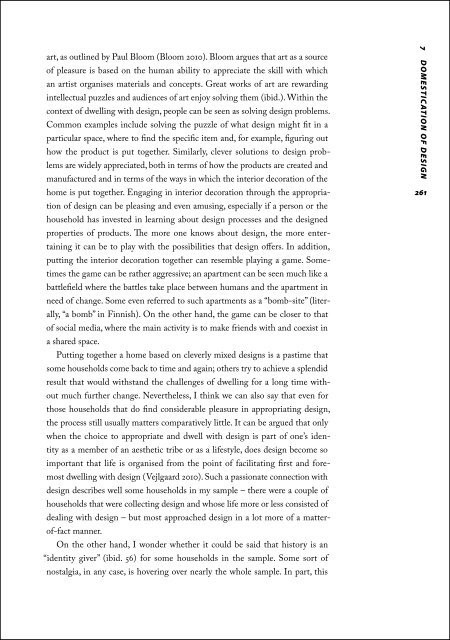Lataa ilmaiseksi
Lataa ilmaiseksi
Lataa ilmaiseksi
Create successful ePaper yourself
Turn your PDF publications into a flip-book with our unique Google optimized e-Paper software.
art, as outlined by Paul Bloom (Bloom 2010). Bloom argues that art as a source<br />
of pleasure is based on the human ability to appreciate the skill with which<br />
an artist organises materials and concepts. Great works of art are rewarding<br />
intellectual puzzles and audiences of art enjoy solving them (ibid.). Within the<br />
context of dwelling with design, people can be seen as solving design problems.<br />
Common examples include solving the puzzle of what design might fit in a<br />
particular space, where to find the specific item and, for example, figuring out<br />
how the product is put together. Similarly, clever solutions to design problems<br />
are widely appreciated, both in terms of how the products are created and<br />
manufactured and in terms of the ways in which the interior decoration of the<br />
home is put together. Engaging in interior decoration through the appropriation<br />
of design can be pleasing and even amusing, especially if a person or the<br />
household has invested in learning about design processes and the designed<br />
properties of products. The more one knows about design, the more entertaining<br />
it can be to play with the possibilities that design offers. In addition,<br />
putting the interior decoration together can resemble playing a game. Sometimes<br />
the game can be rather aggressive; an apartment can be seen much like a<br />
battlefield where the battles take place between humans and the apartment in<br />
need of change. Some even referred to such apartments as a “bomb-site” (literally,<br />
“a bomb” in Finnish). On the other hand, the game can be closer to that<br />
of social media, where the main activity is to make friends with and coexist in<br />
a shared space.<br />
Putting together a home based on cleverly mixed designs is a pastime that<br />
some households come back to time and again; others try to achieve a splendid<br />
result that would withstand the challenges of dwelling for a long time without<br />
much further change. Nevertheless, I think we can also say that even for<br />
those households that do find considerable pleasure in appropriating design,<br />
the process still usually matters comparatively little. It can be argued that only<br />
when the choice to appropriate and dwell with design is part of one’s identity<br />
as a member of an aesthetic tribe or as a lifestyle, does design become so<br />
important that life is organised from the point of facilitating first and foremost<br />
dwelling with design (Vejlgaard 2010). Such a passionate connection with<br />
design describes well some households in my sample – there were a couple of<br />
households that were collecting design and whose life more or less consisted of<br />
dealing with design – but most approached design in a lot more of a matterof-fact<br />
manner.<br />
On the other hand, I wonder whether it could be said that history is an<br />
“identity giver” (ibid. 56) for some households in the sample. Some sort of<br />
nostalgia, in any case, is hovering over nearly the whole sample. In part, this<br />
7 DOMESTIC ATION OF DESIGN<br />
261
















